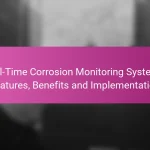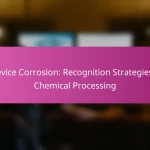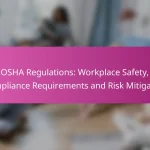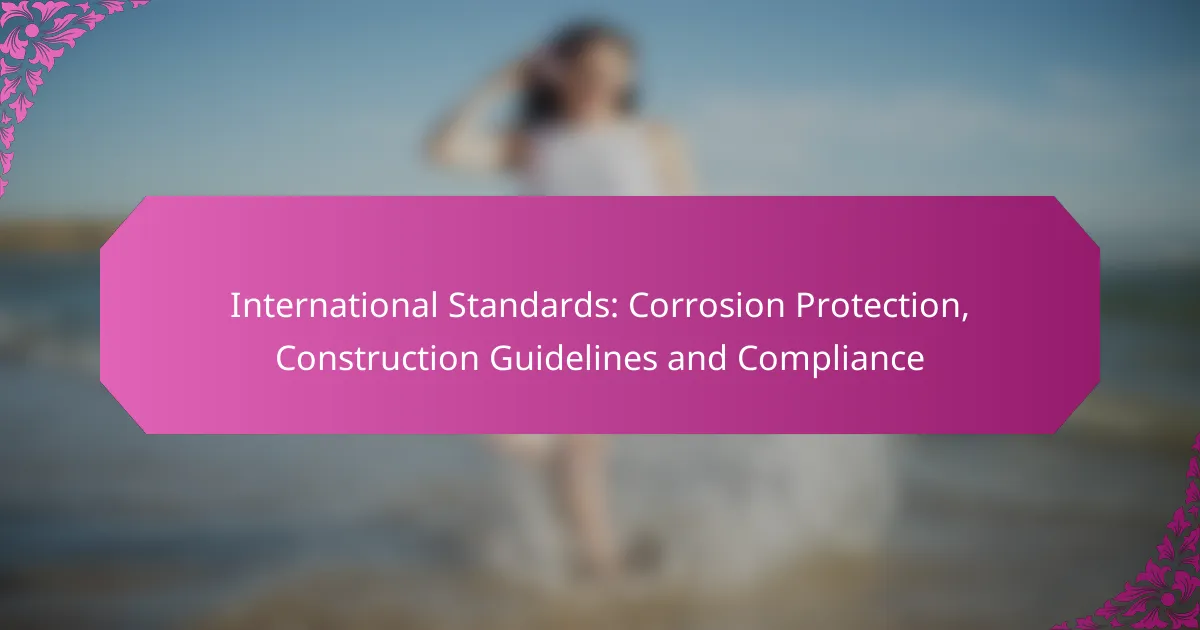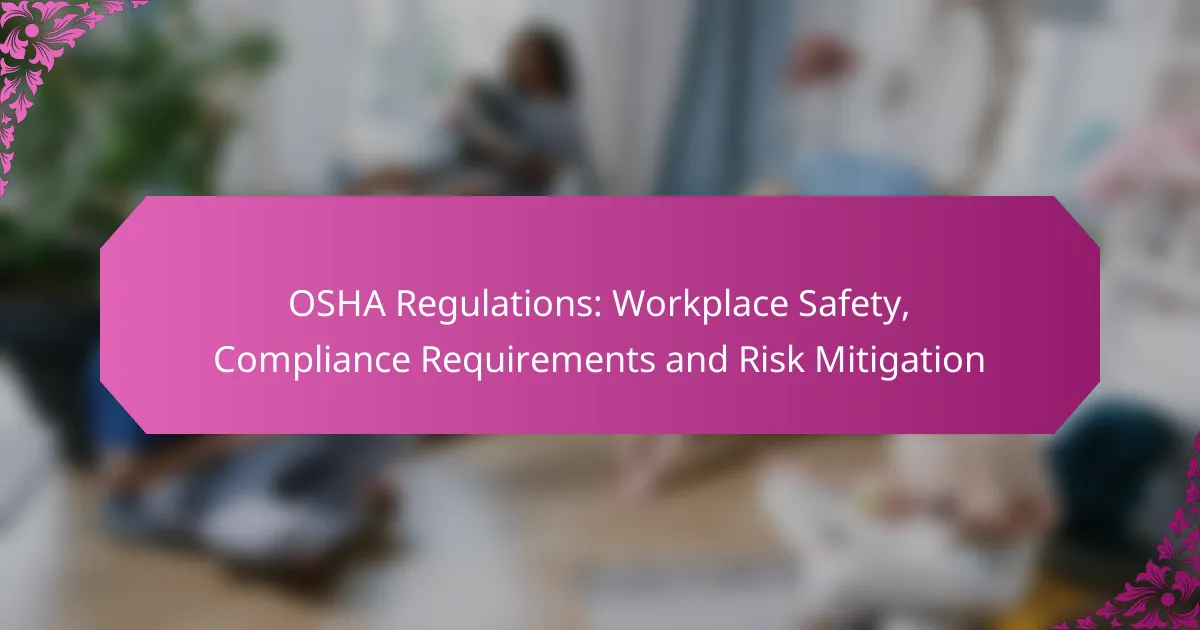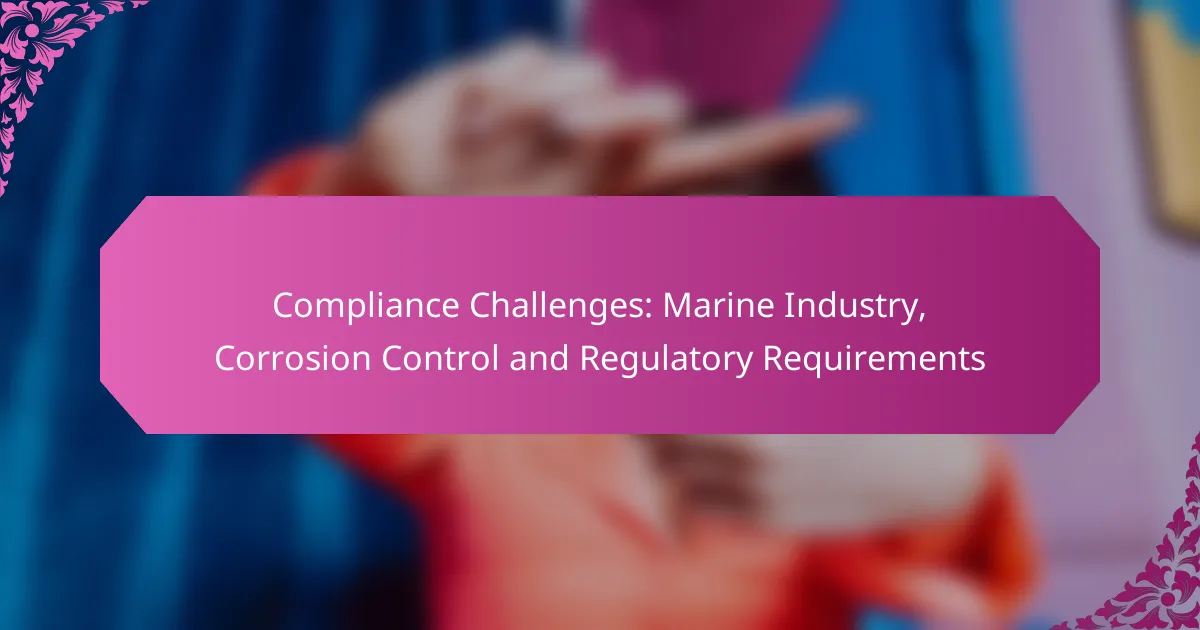International standards for corrosion protection are essential for ensuring the durability and longevity of materials used in construction and manufacturing. By providing comprehensive guidelines, these standards enable organizations to implement effective corrosion management strategies, ultimately enhancing safety and reducing maintenance costs. Compliance with these standards is crucial, as it involves adhering to regulations that safeguard materials and structures from deterioration, tailored to specific industries and locations.

What are the international standards for corrosion protection?
International standards for corrosion protection provide guidelines to ensure the durability and longevity of materials, particularly in construction and manufacturing. These standards help organizations implement effective corrosion management strategies, enhancing safety and reducing maintenance costs.
ISO 12944: Corrosion Protection of Steel Structures
ISO 12944 outlines the requirements for protecting steel structures from corrosion through coatings. It categorizes environments based on corrosivity, guiding the selection of appropriate protective measures. This standard emphasizes the importance of surface preparation, coating application, and maintenance to ensure long-lasting protection.
When applying ISO 12944, consider the environment where the structure will be located. For example, structures in coastal areas may require more robust coatings due to higher salt exposure. Regular inspections and maintenance schedules are crucial to uphold the integrity of the protective measures.
ASTM B117: Salt Spray Testing
ASTM B117 specifies a standardized method for evaluating the corrosion resistance of materials through salt spray exposure. This test simulates harsh marine environments, allowing manufacturers to assess the durability of coatings and finishes. The results help in determining the suitability of materials for specific applications.
During testing, samples are exposed to a saline solution in a controlled environment for a set duration. The performance is evaluated based on the extent of corrosion observed. Regular use of this standard can help ensure that products meet industry expectations for corrosion resistance.
EN 10088: Stainless Steel Corrosion Resistance
EN 10088 focuses on the corrosion resistance of stainless steels, detailing the requirements for various grades and their applications. This standard provides guidance on selecting appropriate stainless steel types based on their resistance to different corrosive environments. Understanding these classifications is essential for engineers and architects in material selection.
For instance, austenitic stainless steels are often preferred for their excellent corrosion resistance in acidic environments, while ferritic grades may be suitable for less aggressive conditions. Proper selection based on EN 10088 can significantly enhance the longevity of stainless steel components in construction.
ISO 8501: Visual Assessment of Surface Cleanliness
ISO 8501 provides guidelines for visually assessing the cleanliness of surfaces before coating applications. This standard helps ensure that surfaces are adequately prepared to maximize adhesion and corrosion protection. It categorizes surface cleanliness levels, which are crucial for successful coating performance.
Common assessments include evaluating rust, mill scale, and other contaminants. Following ISO 8501 can prevent common pitfalls such as premature coating failure due to inadequate surface preparation. Regular training for personnel on these standards can enhance compliance and improve overall project outcomes.
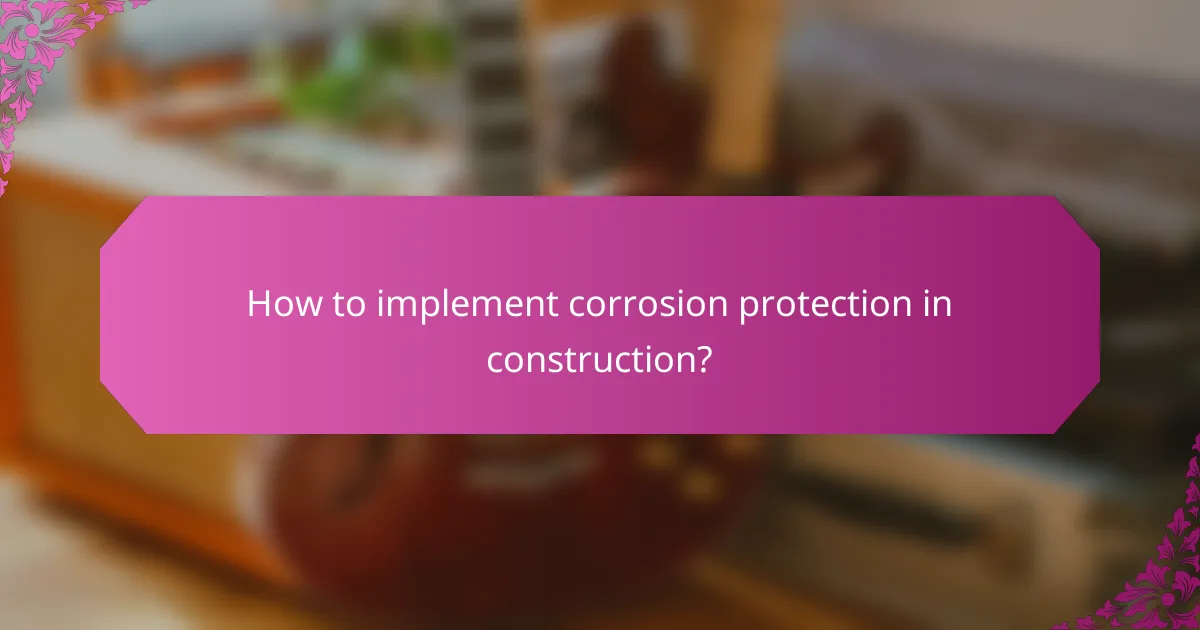
How to implement corrosion protection in construction?
Implementing corrosion protection in construction involves selecting appropriate materials and applying effective techniques to prevent deterioration. Key steps include surface preparation, coating application, and establishing regular maintenance protocols.
Surface Preparation Techniques
Surface preparation is crucial for effective corrosion protection. This process typically involves cleaning the surface to remove contaminants like rust, dirt, and oils, which can hinder adhesion. Techniques such as abrasive blasting, power washing, or chemical cleaning are commonly used.
It is essential to assess the substrate material and choose the right preparation method. For example, steel surfaces may require sandblasting to achieve the desired cleanliness, while concrete may need grinding or acid etching. Proper surface preparation can significantly enhance the longevity of protective coatings.
Coating Application Methods
Coating application methods vary based on the type of coating and the surface being treated. Common methods include brush, roller, and spray application, each offering different advantages. Spray application is often preferred for large areas due to its efficiency and uniform coverage.
When applying coatings, consider environmental factors such as temperature and humidity, which can affect curing times and adhesion. Following manufacturer guidelines regarding thickness and application conditions is vital to ensure optimal performance of the protective layer.
Regular Maintenance Protocols
Establishing regular maintenance protocols is essential for sustaining corrosion protection over time. This includes routine inspections to identify any signs of wear or damage to protective coatings. Inspections should be conducted at least annually, or more frequently in harsh environments.
Maintenance tasks may involve touch-up painting, cleaning surfaces to remove debris, and reapplying coatings as needed. Keeping detailed records of maintenance activities can help track the effectiveness of corrosion protection measures and inform future actions.

What are the compliance requirements for corrosion protection?
Compliance requirements for corrosion protection involve adhering to various regulations and standards that ensure materials and structures are adequately protected from corrosion. These requirements vary by location and industry, focusing on safety, durability, and environmental impact.
Local Building Codes
Local building codes dictate the minimum standards for construction practices, including corrosion protection measures. These codes often specify the types of materials that can be used, the methods of application, and the necessary inspections to ensure compliance.
For example, in the United States, the International Building Code (IBC) may require specific corrosion-resistant materials for structures exposed to harsh environments, such as coastal areas. Always check local amendments to the IBC or other relevant codes for specific requirements.
Environmental Regulations
Environmental regulations govern the impact of construction activities on the surrounding ecosystem, including the use of materials that may contribute to corrosion. These regulations often focus on the prevention of pollutants and the use of eco-friendly materials.
In the European Union, for instance, the REACH regulation restricts the use of certain hazardous substances in construction materials, which can affect corrosion protection strategies. Compliance with these regulations is essential to avoid fines and ensure sustainable practices.
Industry-Specific Guidelines
Different industries have specific guidelines that outline best practices for corrosion protection. These guidelines are often developed by industry associations and may include recommendations for materials, design considerations, and maintenance practices.
For example, the oil and gas industry follows standards set by organizations like the National Association of Corrosion Engineers (NACE), which provides detailed recommendations for corrosion prevention in pipelines and storage tanks. Adhering to these guidelines can significantly reduce the risk of corrosion-related failures.
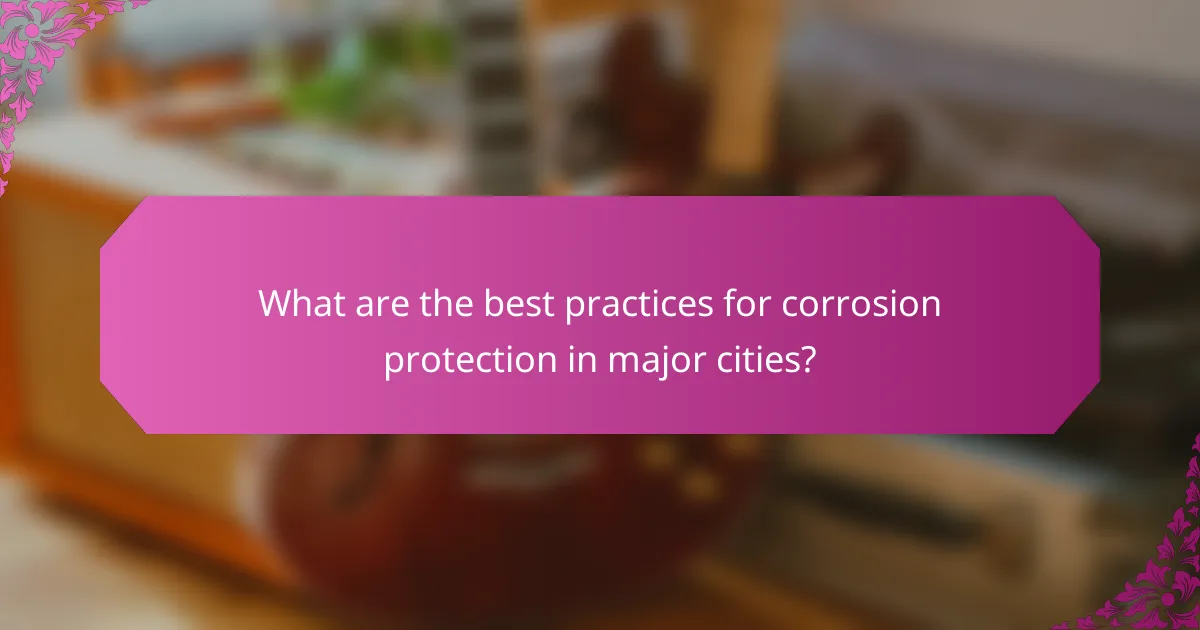
What are the best practices for corrosion protection in major cities?
The best practices for corrosion protection in major cities involve using high-quality materials, regular maintenance, and implementing protective coatings. These strategies help mitigate the effects of environmental factors such as moisture, pollution, and temperature fluctuations that contribute to corrosion.
Case Studies from New York
New York City has implemented several corrosion protection measures, particularly in its extensive subway system. The use of epoxy coatings on metal structures has proven effective in preventing rust and extending the lifespan of critical infrastructure.
Additionally, regular inspections and maintenance schedules are crucial. The Metropolitan Transportation Authority (MTA) conducts annual assessments to identify vulnerable areas and apply necessary treatments, ensuring the integrity of the system.
Best Practices in London
In London, corrosion protection focuses on the use of stainless steel and galvanized materials in construction. These materials are particularly beneficial in the city’s damp climate, where moisture can accelerate corrosion.
Moreover, the city emphasizes the importance of drainage systems to prevent water accumulation, which can lead to corrosion. Regular maintenance checks help identify and address potential issues before they escalate.
Corrosion Management in Sydney
Sydney’s approach to corrosion management includes the use of cathodic protection systems, especially for marine structures exposed to saltwater. This technique involves applying a small electrical charge to prevent corrosion on metal surfaces.
Furthermore, the city promotes the use of protective coatings and paints that are specifically designed to withstand the harsh coastal environment. Regular monitoring and maintenance are essential to ensure these protective measures remain effective over time.
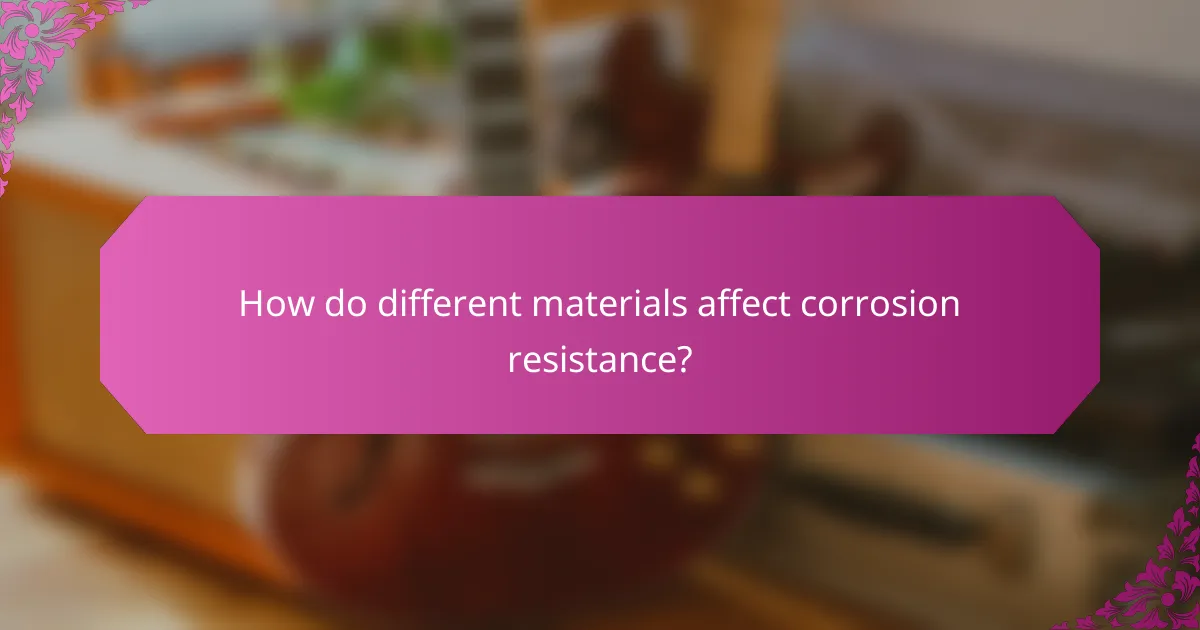
How do different materials affect corrosion resistance?
Different materials exhibit varying levels of corrosion resistance, which is crucial for construction and infrastructure durability. Factors such as environmental exposure, material composition, and protective coatings significantly influence how well a material can withstand corrosion over time.
Steel vs. Aluminum Performance
Steel and aluminum have distinct corrosion resistance characteristics. Steel, while strong and cost-effective, is prone to rust when exposed to moisture unless treated with protective coatings or alloys. Aluminum, on the other hand, naturally forms a protective oxide layer that enhances its resistance to corrosion, making it suitable for environments with high humidity or salt exposure.
When choosing between steel and aluminum, consider the application environment. Steel may require additional protective measures, such as galvanization or painting, to prevent corrosion. Aluminum, while generally more resistant, can still corrode in specific conditions, such as in contact with certain metals or in acidic environments.
In terms of cost, steel is typically less expensive than aluminum, but the long-term maintenance costs for steel can offset initial savings. Evaluate the total lifecycle costs, including maintenance and replacement, to make an informed decision.
